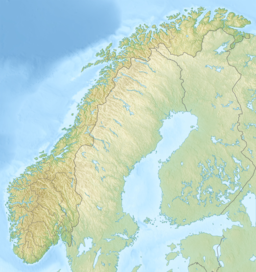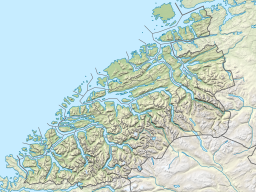Geirangerfjord
| Geirangerfjorden | |
|---|---|
 View of the fjord | |
| Location | Sunnmøre, Møre og Romsdal |
| Coordinates | 62°07′16″N 7°07′44″E / 62.1210°N 7.1290°E |
| Primary inflows | Geirangelva river |
| Primary outflows | Sunnylvsfjorden |
| Basin countries | Norway |
| Max. length | 15 km (9.3 mi) |
| Max. width | 1.5 km (0.93 mi) |
| Settlements | Geiranger |
| Official name | West Norwegian Fjords: Geirangerfjord and Nærøyfjord |
| Type | Natural |
| Criteria | vii, viii |
| Designated | 2005 (29th session) |
| Reference no. | 1195 |
| Region | Europe |
The Geiranger Fjord[1][2][3] (Norwegian: Geirangerfjorden) is a fjord in the Sunnmøre region of Møre og Romsdal county, Norway. It is located entirely in the Stranda Municipality. It is a 15-kilometre-long (9+1⁄2 mi) branch off the Sunnylvsfjorden, which is a branch off the Storfjorden (Great Fjord). The small village of Geiranger is located at the end of the fjord where the Geirangelva river empties into it.
The fjord
[edit]The fjord is one of Norway's most visited tourist sites. In 2005, it was listed as a UNESCO World Heritage Site, jointly with the Nærøyfjorden. This status was challenged by the disputed plans to build power lines across the fjord.[4][needs update]
A car ferry, which doubles as a sightseeing trip, is operated by Fjord1 Nordvestlandske. It runs lengthwise along the fjord between the small towns of Geiranger and Hellesylt. The fjord is scheduled to require zero-emissions ships in 2026.[5]
Along the fjord's sides there lie a number of now-abandoned farms. Some restoration has been made by the Storfjordens venner association. The most commonly visited among these are Skageflå, Knivsflå, and Blomberg. Skageflå may also be reached on foot from Geiranger, while the others require a boat excursion. The fjord is also host to several waterfalls such as Seven Sisters Falls.
Magdalene Thoresen, Henrik Ibsen's mother-in-law, said of the area:
This fjord is surrounded by some of the steepest mountains on the entire west coast. It is very narrow and has no habitable shore area, for the precipitous heights rise in sheer and rugged strata almost straight out of the water. Foaming waterfalls plunge into the fjord from jagged peaks. There are, however, a few mountain farms here, and of these one or two have such hazardous access, by paths that wind around steep precipices, and by bridges that are fixed to the mountain with iron bolts and rings, that they bear witness in a most striking way to the remarkable powers of invention which the challenges of nature have developed in man.[6]
Waterfalls
[edit]The two most notable waterfalls in the Geiranger Fjord are Seven Sisters Falls and the Suitor (Nynorsk Friaren). Both falls face one another across the fjord, and the Suitor is said to be trying to woo the sisters opposite.
The Bridal Veil is another waterfall in the fjord, so named because it falls delicately over one rocky edge, and when seen backlit by the sun it has the appearance of a thin veil over the rocks.
Rock slides
[edit]The Geiranger Fjord is under constant threat from the mountain Åkerneset which is about to erode into the fjord. A collapse would produce a tsunami, hitting several nearby towns including Geiranger and Hellesylt in about ten minutes.[7][8][9]
In popular culture
[edit]- The 2015 movie The Wave (Bølgen) is based on the premise of a rock slide from the mountain Åkerneset inundating the town of Geiranger.[10]
- Frozen used the landscapes of the Geirangerfjord and Nærøyfjord as basis for the landscapes of Arendelle.[11]
Gallery
[edit]-
The Geiranger Fjord is a UNESCO World Heritage Site
-
Geiranger fjord from climb parking lot (panorama)
-
Geiranger fjord from Dalsnibba
-
Seven Sisters (De syv søstrene) and the Suitor (Friaren) waterfalls.
-
A historical photograph of the fjord with Seven Sisters Falls
-
Seven Sisters Falls making its way to the Geiranger Fjord
References
[edit]- ^ Maxtone-Graham, John. 2000. Liners to the Sun. Dobbs Ferry, NY: Sheridan House, p. 422.
- ^ Saintot, A. et al. 2011. Inheritance of Ductile and Brittle Structures in the Development of Large Rock Slope Instabilities: Examples from Western Norway. In: Michel Jaboyedoff (ed.), Slope Tectonics, pp. 27–78. London: The Geological Society of London, p. 62.
- ^ Gutiérrez, Mateo. 2005. Climatic Geomorphology. Transl. G. Benito et al. Amsterdam: Elsevier, p. 87.
- ^ "Geirangerfjorden kan miste verdensarvstatus". Bergens Tidende (in Norwegian). 6 July 2007. Archived from the original on 30 September 2007. Retrieved 7 July 2007.
- ^ "Norway challenges the cruise industry to operate emission free". DNV GL. 25 February 2019.
- ^ History about Bringe-Ragnhild. "History about Bringe-Ragnhild". Archived from the original on 2008-08-04. Retrieved 2011-07-25.
- ^ "Gigantras truer vestlandsbygder". Aftenposten (in Norwegian). 14 November 2004. Archived from the original on 17 July 2012. Retrieved 7 July 2007.
- ^ "Økt fare for fjellskred i Åkersneset" (in Norwegian). forskning.no. 22 April 2004. Archived from the original on 29 September 2007. Retrieved 7 July 2007.
- ^ "High Resolution Digital Elevation Model Analysis for Landslide Hazard Assessment (Åkerneset, Norway)". Archived from the original on 2006-07-16. Retrieved 2007-06-25.
- ^ "The Wave (2015) Bølgen (original title)". IMDb. Retrieved 16 March 2016.
- ^ Harpaz, Beth (5 June 2014). "How Disney's Frozen frenzy is creating a craze for Geirangerfjord | The Star". Toronto Star. Retrieved 2022-08-10.
External links
[edit] Geirangerfjord travel guide from Wikivoyage
Geirangerfjord travel guide from Wikivoyage- Geiranger Tourist-Info
- Destination Geirangerfjord - Ålesund & Sunnmøre Archived 2011-03-24 at the Wayback Machine
- Geirangerfjord - the official travel guide to Norway
- Travel information Archived 2021-01-15 at the Wayback Machine








